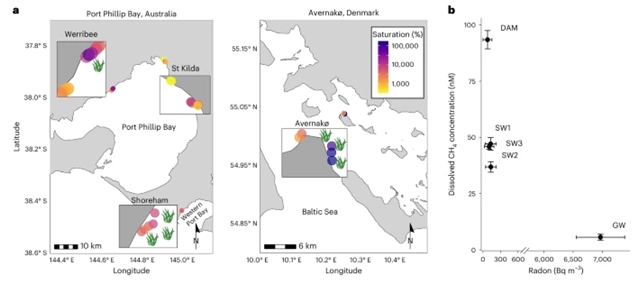
近日,澳大利亚莫纳什大学Cook, P. L. M.团队揭示了利用海藻和海草代谢物的耐氧产甲烷菌驱动的沿海甲烷排放。相关论文于2025年8月7日发表在《自然—地球科学》杂志上。
人们认为产甲烷仅限于严格缺氧的环境。虽然含氧海洋是已知的甲烷环境,但有人认为甲烷的产生是由甲基膦酸降解细菌和潜在的其他环境驱动的,而不是由产甲烷的古细菌驱动的。
研究组结合生物地球化学、宏基因组学和培养实验,开展原位监测和移地操作实验,证明了古细菌在频繁氧化的沙质沉积物中快速产生甲烷。研究表明,沙质沉积物的甲烷排放不会被反复的氧气暴露所抑制,这一活动是由广泛分布于沙质沉积物表层的耐氧甲基营养化产甲烷菌(主要是Methanosarcinaceae)驱动的。此外,研究组发现甲烷排放是由甲基化的海藻和海草代谢物驱动的,揭示了初级生产和温室气体排放之间的反馈循环。
附:英文原文
Title: Coastal methane emissions driven by aerotolerant methanogens using seaweed and seagrass metabolites
Author: Hall, N., Wong, W. W., Lappan, R., Ricci, F., Jeppe, K. J., Glud, R. N., Kawaichi, S., Rotaru, A-E., Greening, C., Cook, P. L. M.
Issue&Volume: 2025-08-07
Abstract: Methanogenesis is thought to be limited to strictly anoxic environments. While oxygenated oceans are a known methane source, it is argued that methane production is driven by methylphosphonate-degrading bacteria and potentially other sources rather than by methanogenic archaea. Here we develop in situ monitoring and ex situ manipulation experiments, combined with biogeochemical, metagenomic and culture-based experiments, to show that methane is rapidly produced by archaea in frequently oxygenated sandy sediments. We show that methane emissions from sandy sediments are not inhibited by repeated oxygen exposure and suggest the activity is driven by aerotolerant methylotrophic methanogens (primarily Methanosarcinaceae) broadly distributed in the surface layers of sandy sediments. Moreover, we show that methane emissions are driven by methylated seaweed and seagrass metabolites, revealing a feedback loop between primary production and greenhouse gas emissions.
DOI: 10.1038/s41561-025-01768-3
Source: https://www.nature.com/articles/s41561-025-01768-3
